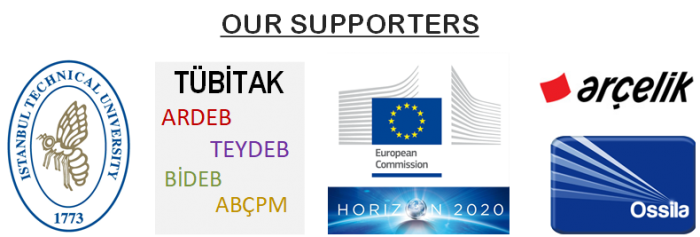Projects
From The Emerging Circuits and Computation Group at ITU
(Difference between revisions)
|
|
| Line 22: |
Line 22: |
| | |- valign="top" | | |- valign="top" |
| | | '''funding agency & program''': | | | '''funding agency & program''': |
| − | | width="400"| [https://www.tubitak.gov.tr/en/content-2501-joint-research-program-with-national-science-foundation-nsf TUBITAK Bilateral Cooperation Program (2501)] | + | | width="400"| [http://www.tubitak.gov.tr/en/content-2501-joint-research-program-with-national-science-foundation-nsf TUBITAK Bilateral Cooperation Program (2501)] |
| | |- valign="top" | | |- valign="top" |
| | | '''budget''': | | | '''budget''': |
| Line 40: |
Line 40: |
| | |- valign="top" | | |- valign="top" |
| | | '''principal investigator / coordinator''': | | | '''principal investigator / coordinator''': |
| − | | Prof. Csaba A. Moritz, [http://www.umass.edu/nanofabrics/ University of Massachusetts], USA | + | | Prof. Csaba A. Moritz, [http://www.umass.edu/ University of Massachusetts], USA |
| | |- valign="top" | | |- valign="top" |
| | | '''funding agency & program''': | | | '''funding agency & program''': |
| − | | width="400"| [https://www.nsf.gov/funding/pgm_summ.jsp?pims_id=503301 NSF Software and Hardware | + | | width="400"| [http://www.nsf.gov/funding/pgm_summ.jsp?pims_id=503301 NSF Software and Hardware Foundation Program] |
| − | Foundation Program] | + | |
| | |- valign="top" | | |- valign="top" |
| | | '''budget''': | | | '''budget''': |
Revision as of 12:15, 18 April 2019
Listed below are the projects coordinated by our group.
Main Projects
| TUBITAK - NSF JOINT RESEARCH PROJECT
TUBITAK:
NSF:
|
This project
- aims to implement energy-efficient circuits / systems that occupy very low area with switching lattices;
- develops a new CMOS-compatible technology based on switching lattice structures; and
- introduces circuit models and EDA tools for the developed technology.
|
|
|
| title:
|
Synthesis and Performance Optimization of a Switching Nano-Crossbar Computer
|
| acronym:
|
NANOxCOMP
|
| principal investigator / coordinator:
|
Mustafa Altun, Istanbul Technical University
|
| partner(s):
|
- Dr. Dan Alexandrescu, IROC Techonogies, France
- Prof. Lorena Anghel, TIMA Lab., France
- Prof. Valentina Ciriani, ALOS Lab., University of Milan, Italy.
- Prof. Csaba A. Moritz, Nanoscale Computing Fabrics Lab., University of Massachusetts, USA
- Prof. Kaushik Roy, Nanoelectronics Research Lab., Purdue University, USA
- Prof. Mircea Stan, High-Performance Low-Power Lab., University of Virginia, USA
- Prof. Mehdi B. Tahoori, Dependable Nano-Computing Group, Karlsruhe Institute of Technology, Germany
|
| funding agency & program:
|
European Union/European Commission H2020 MSCA Research and Innovation Staff Exchange Program (RISE)
|
| budget:
|
724.500 EURO
|
| duration:
|
2015-2019
|
|
This project
- gathers globally leading research groups working on nanoelectronics and EDA;
- targets variety of emerging technologies including nanowire/nanotube crossbar arrays, magnetic switch-based structures, and crossbar memories; and
- contributes to the construction of emerging computers beyond CMOS by proposing nano-crossbar based computer architectures.
|
|
|
|
|
This project
- targets image processing and neuromorphic applications including learning;
- proposes reconfigurable circuit-system co-design method with throughout power optimization; and
- involves applications in reconfigurable hardware for image filtering/compression and handwriting recognition.
|
|
|
|
|
This project
- targets technologies necessitating low transistor counts including large-area electronics;
- proposes accurate (error-free) computing techniques for stochastic logic; and
- designs finite state machines working with bit streams.
|
|
|
|
|
This project
- targets fault-aware reversible circuits;
- proposes a synthesis methodology to implement an 8-bit microprocessor; and
- involves design, fabrication, and test of the processor using the AMS 0.35µ CMOS technology.
|
|
|
|
|
This project
- targets future and emerging technologies beyond CMOS;
- proposes new computing models based on regular arrays of switches; and
- offers failure resistant nano architectures.
|
|
|
|
|
This project
- targets electronic circuits and cards produced by one of the Europe’s largest household appliances companies Arcelik A.S. and
- proposes reliability prediction techniques using field return data, new accelerated test methodologies, and physics of failure based simulations.
|
|
|
|
|
This project
- targets technologies of large-area printed and organic electronics; and
- proposes manufacturing and modeling techniques for carbon doped P3HT and TIPS-Pentacene transistors.
|
|
|
Small/Supportive Projects




